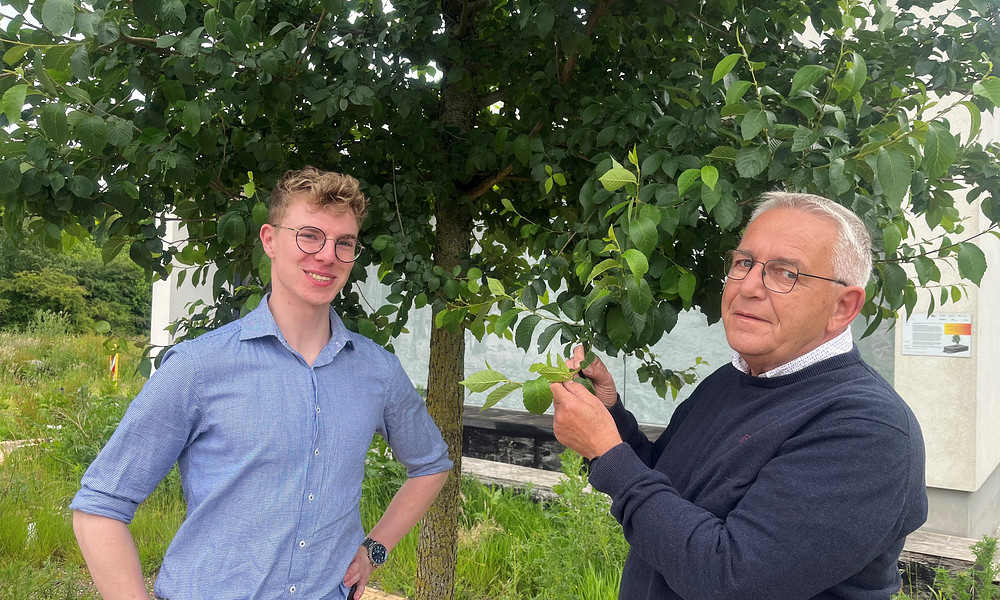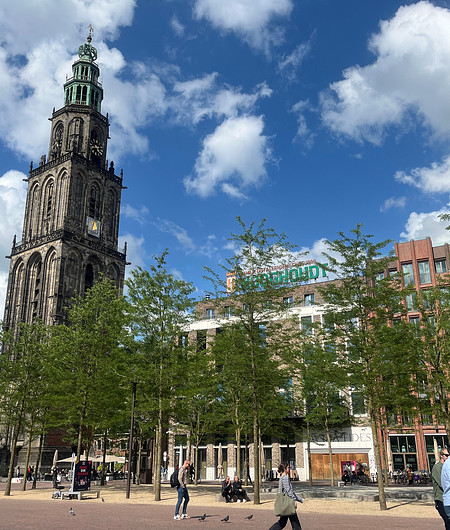Hanze develops tree growth system on Grote Markt
- News


On Saturday 1 June, a festive opening was held of the newly refurbished Grote Markt. The square is now adorned with 24 trees, seating areas and two water features with fountains. Piet Zijlstra and Jurre van der Velde investigated how the trees on the Grote Markt can grow into monumental specimens that provide coolness and shade.
Text and photos: Loes Vader
"I'm doing an internship at BuildinG, the place to be at the Hanze for sustainability and circular construction," says Jurre van der Velde as he gives a tour of the old recycled tennis hall behind ENTRANCE. The second-year Built Environment student explains that trees in an urban environment usually don't live longer past twenty years or so, while trees can live up to a century. "The municipality of Groningen wanted to give the Grote Markt a new look with more greenery, so that the 'hot square', as we call it, would become more attractive to the public. Trees have a cooling effect and they can absorb a lot of water during extreme rain. To allow the trees to grow, a system was applied that we monitored here with sensors."
The tree doctors of the municipality of Groningen knocked on Piet Zijlstra's door to ask if he could test the tree growth system at BuildinG. Among other things, Zijlstra is the driving force behind the Hanze climate testing grounds and circular and biobased construction. "A resistant elm, a tree that is resistant to the deadly Dutch elm disease, was given a place next to BuildinG. We would like to see the elm return in urban areas," Zijlstra explains. "We have been monitoring the tree for two years now. Did we get it right and does the system work as it should? We measure oxygen and moisture. We also pay attention to leaf colour, shoot length and trunk size. The system runs on rainwater that comes from the roof of the building next to us. We have seen that the tree is thriving. The research results are far beyond our expectations."
Jurre: "That's due to the system that Piet and the tree doctors have devised. There is a crate system at the bottom, two layers of plastic crates of about 15 centimetres high, there are pylons in them that increase the capillary action, which is the ability of porous materials to absorb and retain water. We have selected special types of tree soil. In the greasy Groningen sea clay, trees don't grow the way we want them to. A tree needs 12 to 16 cubic metres of space to develop."
The trees on the Grote Markt - ten pagoda trees and fourteen honey locusts (Gleditsia triacanthos) - can root downwards and therefore do not crush the pavement. Zijlstra: "A tree is always looking for water, if it can't go deep, it will look for it on the surface. The root system is as large as the crown of the tree. On the Grote Markt, we have also installed a crate system on the surface to create a false ground level, so that you traffic can go across. The crates distribute the pressure. Another special feature of the Grote Markt is that we are experimenting with a kind of crushed stone around the trees. Can you move through it with a pram or walker without taking parts of the crushed stone with you into the shops?"
Jurre has been involved in the grading of the crushed stone, research of the semi-pavement grit and is conducting surveys among the public. "We ask visitors and shopkeepers what they think of the pavement and the tree clusters. We will continue to do so throughout the project. We get a lot of positive reactions. Only the cleaners are still a bit sceptical about the new situation."
The researchers will continue to monitor the tree growth system on the Grote Markt. "There, too, we measure moisture and oxygen with computer-controlled sensors. In theory, we don't need to give the trees extra water, the system has to be self-supporting. But the climate is changeable, so we can't say that with certainty. The trees have made the Grote Markt an attractive square. When the trees have grown further, the square will become even more attractive. It's nice to have been able to contribute to that," says Piet.
"It would be really cool if I could take my children here in the future," says Jurre. "I'm sure you're going to experience that," Zijlstra concludes. "I have children of my own and now also grandchildren and I want them to have a good life on this planet. Which means you have to act now and make sure that young people are taught the value of innovation during their education. We are now seeing that we cannot maintain that one and a half degrees of warming. Just talking takes up too much time, we need action."
How satisfied are you with the information on this page?